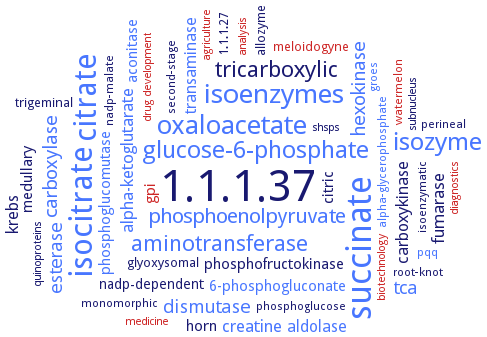1.1.1.37: malate dehydrogenase
This is an abbreviated version!
For detailed information about malate dehydrogenase, go to the full flat file.

Word Map on EC 1.1.1.37 
-
1.1.1.37
-
succinate
-
isocitrate
-
citrate
-
isoenzymes
-
oxaloacetate
-
isozyme
-
glucose-6-phosphate
-
tricarboxylic
-
aminotransferase
-
phosphoenolpyruvate
-
carboxylase
-
hexokinase
-
dismutase
-
esterase
-
tca
-
alpha-ketoglutarate
-
creatine
-
fumarase
-
aldolase
-
carboxykinase
-
transaminase
-
krebs
-
phosphoglucomutase
-
aconitase
-
gpi
-
horn
-
citric
-
medullary
-
phosphofructokinase
-
6-phosphogluconate
-
nadp-dependent
-
trigeminal
-
1.1.1.27
-
allozyme
-
meloidogyne
-
glyoxysomal
-
groes
-
nadp-malate
-
alpha-glycerophosphate
-
watermelon
-
phosphoglucose
-
pqq
-
monomorphic
-
second-stage
-
isoenzymatic
-
root-knot
-
perineal
-
diagnostics
-
drug development
-
biotechnology
-
analysis
-
subnucleus
-
quinoproteins
-
medicine
-
agriculture
-
shsps
- 1.1.1.37
- succinate
- isocitrate
- citrate
- isoenzymes
- oxaloacetate
- isozyme
- glucose-6-phosphate
-
tricarboxylic
- aminotransferase
- phosphoenolpyruvate
- carboxylase
- hexokinase
- dismutase
- esterase
- tca
- alpha-ketoglutarate
- creatine
- fumarase
- aldolase
-
carboxykinase
- transaminase
-
krebs
- phosphoglucomutase
- aconitase
- gpi
-
horn
-
citric
-
medullary
-
phosphofructokinase
- 6-phosphogluconate
-
nadp-dependent
-
trigeminal
-
1.1.1.27
-
allozyme
- meloidogyne
- glyoxysomal
- groes
-
nadp-malate
- alpha-glycerophosphate
- watermelon
-
phosphoglucose
- pqq
-
monomorphic
-
second-stage
-
isoenzymatic
-
root-knot
-
perineal
- diagnostics
- drug development
- biotechnology
- analysis
-
subnucleus
-
quinoproteins
- medicine
- agriculture
-
shsps
Reaction
Synonyms
(R)-2-hydroxyacid dehydrogenase, (S)-malate dehydrogenase, A8B73_11505, CaMDH, cMDH, cMDH -S, cMDH-L, cyMDH, cyMDH1, cyMDH2, cyMDH3, cytMDH, cytMDH1, cytosolic malate dehydrogenase, cytosolic malate dehydrogenase 1, cytosolic MDH, cytosolic NAD-dependent malate dehydrogenase, flo16, floury endosperm16, halophilic malate dehydrogenase, HmMalDH, L-malate dehydrogenase, L-malate dehydrogenases, L-malate-NAD oxidoreductase, L-malate-NAD-oxidoreductase, L-malate: NAD oxidoreductase, L-malate: NAD+ oxidoreductase, L-malate:NAD oxidoreductase, L-malate:NAD-oxidoreductase, L-MDH, LDH-like malate dehydrogenase, ldh0076, LEUM_0076, m-MDH, malate (NAD) dehydrogenase, malate dehydrogenase, malate dehydrogenase (NAD), malate dehydrogenase 1, malate dehydrogenase 2, malate: NAD oxidoreductase, MalDH, malic acid dehydrogenase, malic dehydrogenase, mbNAD-MDH, MDH, MDH A, MDH B1, MDH B2, Mdh1, MDH2, Mdh2a, Mdh2b, Mdh3, mitochondrial malate dehydrogenase, mitochondrial MDH, mMDH, mNAD-MDH, More, NAD+ malate dehydrogenase, NAD+-dependent malate dehydrogenase, NAD+-dependent MDH, NAD+-MDH enzymes, NAD-dependent cytosolic malate dehydrogenase, NAD-dependent malate dehydrogenase, NAD-dependent MalDH, NAD-dependent malic dehydrogenase, NAD-dependent MDH, NAD-L-malate dehydrogenase, NAD-linked malate dehydrogenase, NAD-malate dehydrogenase, NAD-malic dehydrogenase, NAD-MDH, NAD-specific malate dehydrogenase, NADP+-dependent malate dehydrogenase, Pcal_1699, pdNAD-MDH, peroxisomal malate dehydrogenase, peroxisomal NAD+-malate dehydrogenase 1, peroxisomal NAD+-malate dehydrogenase 2, plastid-localized NAD-dependent MDH, plastidial NAD+-dependent malate dehydrogenase, plastidial NAD-dependent malate dehydrogenase, plastidial NAD-dependent malate dehydrogenase 1, plNAD-MDH, PMDH, PMDH1, PMDH2, regulatory subunit of nucleic acid-conducting channel, s-MDH, SrMalDH, TaMDH, VEG69, Vegetative protein 69, YlMdh2p, [LDH-like] MDH


 results (
results ( results (
results ( top
top





